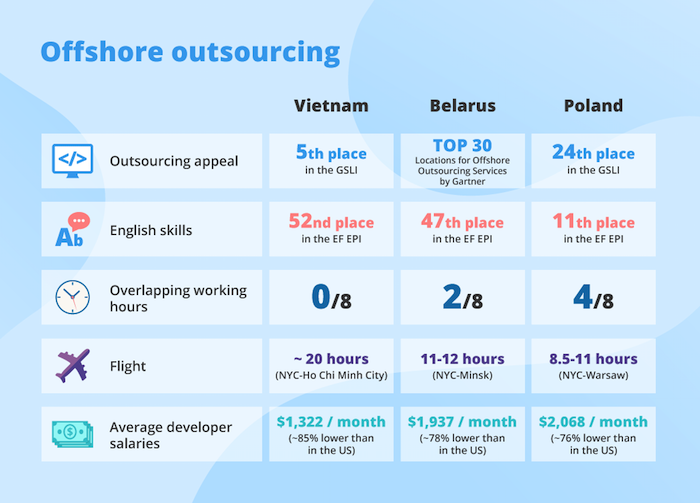

Updated June 26, 2025
Every software development project is different, and what works for some won’t work for others. We’ll explore the pros and cons of both nearshore and offshore outsourcing, so you can identify the best partner for your engagement.
For years, companies have turned to offshore outsourcing teams to help them achieve their software development goals. While lower development costs continue to be the driver for outsourcing abroad, some companies are now seeking other advantages as well.
Convenience, a wide variety of vendors to select from, easy access to technologies and lack of cultural barriers all play a role in the decision to outsource. Nearshore providers are an increasingly attractive option for companies who value those factors over cost.
Looking for a Software Development agency?
Compare our list of top Software Development companies near you
If you’re planning to outsource a software development project, and you’re not sure where to turn, we’ve got you covered. We’ll go over some advantages and drawbacks of both nearshore and offshore outsourcing, as well as project types and common destinations, so you can decide which option fits your needs best.
1. Pros and cons of nearshore outsourcing
2. When nearshoring is the right choice
3. Common nearshore outsourcing destinations
4. Offshore outsourcing’s benefits and drawbacks
5. What projects offshore outsourcing fits best
6. Where to find your outsourcing provider
Nearshore outsourcing refers to the practice of hiring vendors from a neighboring country. There are several common pros and cons to take into account before you make your decision.
For instance, nearshore outsourcing brings the benefit of onshore outsourcing, but at a lower cost. Additionally, similar time zones allow for frequent real-time communication, and geographical proximity makes face-to-face meetings easier to manage. This can be a huge benefit when dealing with complicated software development projects.
However, compared to offshore outsourcing, there are far fewer options to choose from. That results in a limited pool and diversity of talents and, consequently, a more limited (and more expensive) access to advanced technologies.
For those in the US, the majority of nearshore locations are only “near” in name. Flights to common nearshore outsourcing vendors can take up to 10 hours. If close proximity is a must-have, your selection of qualified vendors decreases again.
Now that you know a little more about what to expect from a nearshore vendor, it’s time to take a look at your project and decide whether nearshoring will be a good fit.
Nearshore outsourcing might be the right choice for you if you’re looking to augment your in-house team in Agile projects. In those types of projects, constant communication between project team members is the foundation of the development process and can mean the difference between a successful project and a failed one.
For full project outsourcing that requires a tight collaboration between project stakeholders and the outsourced team, nearshoring is a good choice as well. And finally, for larger projects, where regular on-site visits from both sides are needed to launch the project and manage its progress, it’s best to find a vendor close to home.
So, you’ve decided nearshore outsourcing is the best decision for your project. But if you’re still not sure where to start, we’ll outline profiles of 3 common nearshoring destinations with the critical benefit of being close to the US.

Canada accumulates talented developers from around the world thanks to its immigration policy, which promotes hiring skilled foreign labor. The country is renowned for their massive investments in AI, with their aim to be a global leader in the technology.
In fact, Canada is ranked 27th in the Global Services Location Index (GSLI), a study on outsourcing attractiveness of 50 destinations worldwide. It has a higher “business environment” score than the US and the majority of countries on the list.
There are logistical benefits to Canada as well. 75.5% of Canadians speak English, and they share a similar culture and history with the US, which eliminates cultural barriers. Their working hours align seamlessly with the United States,’ and its geographical proximity makes business trips short.
As an added bonus, the average Canadian developer salary is about 28% lower than the US’, making it a more affordable software development destination.
Mexico scored 11th in the GSLI due to financial attractiveness and improvements in the business environment and infrastructure in 2019. They develop IT clusters throughout the country to raise the level of the IT industry and boost export services, and as a result, they have a pool of more than 500,000 IT industry professionals.
Like Canada, travel to Mexico is easy for many Americans, and the countries share 7 out of 8 working hours. However, English skills among Mexican vendors can vary, so make sure to check in with your vendor, especially if your project presumes frequent communication.
Another attractive feature of nearshoring with Mexico is the savings. The average developer salary in Mexico is about 80% lower than that in the US.
Known for its safety and stable political environment, Costa Rica houses an advantageous business landscape. They boast Free Trade Zones and tax incentives, which help it rank 44th among the world’s best countries for outsourcing according to the GSLI.
Despite a population of just 5 million, there are almost 300 high-tech multinational companies in Costa Rica, and the country’s exports of IT-related services reached $3.3 billion in 2018.
Among Latin American countries, they score second for English speakers, and their proximity to the United States means short trips and similar time zones. Plus, Costa Rican developer salaries are about 74% lower than their US counterparts.
Offshore outsourcing vendors are those which operate from far abroad. For the US, that’s typically countries in Europe and Asia.
Many clients choose offshore destinations because they open opportunities for all needs and budgets. There are vendors of any scale that offer all kinds of expertise. And cutting-edge technologies are more affordable, as the competition between vendors is higher.
However, despite the cost advantages offshoring presents, it’s not the perfect solution for everyone. Different time zones and greater distance can become a pitfall for collaboration, as can cultural differences and occasional barriers in communication.
To decide whether you should take factors other than cost into consideration, it helps to take a look at what you’re hiring an outsourcing development partner for.
If you’re looking to fill in the skill gap of your team on advanced technologies or narrow domain expertise at a reasonable cost, an offshore outsourcing partner might be a good fit.
Similarly, you might want to look offshore for full project outsourcing with a need for a good price and quality balance — just be sure to choose a vendor with some working time overlap to ease communication.
Lastly, for simple projects where cutting costs is essential, an offshore software development outsourcing partner will be the best choice for you.
There are a lot of offshore outsourcing destinations to choose from, and it can be overwhelming to start. We’ve narrowed the list down to three, to help make your decision a little easier.

The Vietnamese IT outsourcing market is rather young but growing: Vietnam has already become Japan’s second-biggest partner in IT outsourcing. TopDev, a popular IT recruitment platform in Vietnam, has 300,000 developer profiles registered by 2020.
As a result of their remarkably low labor rates, which challenge India’s, and beneficial IT tax regulations, Vietnam takes 5th place in the GSLI. English skills can vary, but if you’re willing to put in the time, you’ll find a vendor whose communication level matches your needs.
However, Vietnam’s distance makes work trips difficult — NYC to Ho Chi Minh City is a 20-hour flight. On top of that, none of Vietnam’s working hours overlap with the US’s, so you’ll have to be comfortable on an inverted working schedule.
Despite the drawbacks, Vietnam’s average developer salaries are around 85% less than their US counterparts, which means significant savings on your end.
Belarus is a small but capable destination for landing a software development project: 60.5% of the country’s IT specialists work in IT outsourcing companies, and Belarusian tech focus is on cutting-edge technologies such as machine learning, big data, IoT and AR/VR.
While English skills vary in the country, for Belarusian project managers, BAs, and developers, fluent English is a requirement. Though closer than their Asian counterparts, a flight to Belarus takes about 12 hours, and only 2 of 8 working hours overlap with the US’.
Plus, if you’re willing to endure the distance, it will definitely pay off. Belarusian developer salaries are about 78% lower than those in the US.
The Polish IT market is one of the fastest-growing in Eastern Europe. The country offers one of the biggest talent supplies in the region, with 279,800 developers and counting. In fact, the number keeps growing at a 10% yearly pace. The country’s IT services sales are forecasted to reach over $15 billion by 2020.
Additional benefits to outsourcing from Poland include the country’s high proficiency in English and a time zone that shares 4 out of 8 working hours with the US. While a flight to Warsaw will put you out half a day, developer salaries in Poland are about 76% below the average for the US.
Both nearshore and offshore outsourcing have advantages and disadvantages, and you should weigh a number of factors before deciding which path is best for your project. These include cost, communication, expertise, and access to technologies.
With this guide and an understanding of your goals and project, you can find the right balance between the three — whether that’s from a nearshore or offshore partner is up to you.


